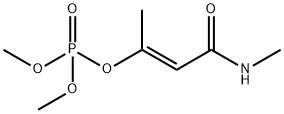
МОНОКРОТОФОС
- английское имяMonocrotophos
- CAS №6923-22-4
- CBNumberCB9266773
- ФормулаC7H14NO5P
- мольный вес223.16
- EINECS230-042-7
- номер MDLMFCD00055291
- файл Mol6923-22-4.mol
| Температура плавления | 54-55°C |
| Температура кипения | 125°C (0.0005 torr) |
| плотность | 1.3300 |
| давление пара | 2.9×10-4 Pa (20 °C) |
| Fp | -18 °C |
| температура хранения | 0-6°C |
| растворимость | Chloroform (Slightly), Methanol (Slightly) |
| пка | 13.06±0.46(Predicted) |
| форма | solid |
| Растворимость в воде | Soluble |
| БРН | 8415832 |
| Пределы воздействия | OSHA PEL: TWA 0.25 mg/m3; ACGIH TLV: TWA 0.25 mg/m3. |
| Стабильность | Temperature Sensitive |
| Рейтинг продуктов питания EWG | 2 |
| FDA UNII | 5Q3PE07Z18 |
| Справочник по химии NIST | Monocrotophos(6923-22-4) |
| Пестициды Закон о свободе информации (FOIA) | Azodrin |
| Система регистрации веществ EPA | Monocrotophos (6923-22-4) |
| Коды опасности | T+;N,N,T+,Xn,F |
| Заявления о рисках | 24-26/28-50/53-68-67-65-38-11-36-20/21/22 |
| Заявления о безопасности | 1/2-36/37-45-60-61-62-26-16 |
| РИДАДР | UN 2783 |
| OEB | C |
| OEL | TWA: 0.25 mg/m3 |
| WGK Германия | 3 |
| RTECS | TC4375000 |
| Класс опасности | 6.1(a) |
| Группа упаковки | II |
| кода HS | 29241200 |
| Банк данных об опасных веществах | 6923-22-4(Hazardous Substances Data) |
| Токсичность | LD50 in male, female rats (mg/kg): 17, 20 orally; 126, 112 dermally (Gaines) |
рисовальное письмо(GHS)
-
рисовальное письмо(GHS)



-
сигнальный язык
опасность
-
вредная бумага
H341:Предполагается, что данное вещество вызывает генетические дефекты.
H410:Чрезвычайно токсично для водных организмов с долгосрочными последствиями.
H311:Токсично при попадании на кожу.
H300+H330:Смертельно при проглатывании или при вдыхании.
-
оператор предупредительных мер
P202:Перед использованием ознакомиться с инструкциями по технике безопасности.
P260:Не вдыхать газ/ пары/ пыль/ аэрозоли/ дым/ туман.
P273:Избегать попадания в окружающую среду.
P280:Использовать перчатки/ средства защиты глаз/ лица.
P302+P352+P312:ПРИ ПОПАДАНИИ НА КОЖУ: Промыть большим количеством воды. Обратиться за медицинской помощью при плохом самочувствии.
P304+P340+P310:ПРИ ВДЫХАНИИ: Свежий воздух, покой. Немедленно обратиться за медицинской помощью.
МОНОКРОТОФОС химические свойства, назначение, производство
Химические свойства
Monocrotophos is a colorless to reddishbrown solid with a mild ester odor.Использование
Monocrotophos is an organophosphorous insecticide. Monocrotophos is used mainly against cotton pests but it is also used in the protection of citrus, rice, potatoes, vegetables and other crops.Определение
ChEBI: An alkenyl phosphate that is the 4-(methylamino)-4-oxobut-2-en-2-yl ester of dimethyl phosphate.Общее описание
Colorless crystals with a mild ester odor, commercial product is a reddish-brown solid. Used as a fast acting insecticide with both systemic and contact action against a wide range of pests on cotton, sugar cane, tobacco, potatoes, peanuts, tomatoes, and ornamentals. Very toxic.Реакции воздуха и воды
Water soluble. Rapidly hydrolyzed.Профиль реактивности
Monocrotophos is incompatible with the following: Metals, low molecular weight alcohols & glycols [Note: Corrosive to black iron, drum steel, stainless steel 304 & brass. Should be stored at 70-80°F.] . Incompatible with alkaline compounds.Опасность
Flammable, dangerous fire risk. Use may be restricted. Toxic via ingestion, inhala- tion, and skin absorption. Questionable carcinogen. Cholinesterase inhibitor.Угроза здоровью
Monocrotophos is an organophosphorus pesticide. It is a cholinesterase inhibitor and acts on the nervous system. Extremely toxic; probable oral lethal dose to humans 5-50 mg/kg or between 7 drops and 1 teaspoon for a 70 kg (150 lb.) person. Repeated inhalation or skin contact with Monocrotophos may, without symptoms, progressively increase susceptibility to poisoning.Пожароопасность
Wear positive pressure breathing apparatus and full protective clothing. Container may explode in heat of fire. Toxic fumes evolved when heated to decomposition. Incompatible with alkaline compounds. Unstable in aqueous solution above pH 7.0; in low molecular weight alcohols and glycols. Stable in ketones and higher molecular weight alcohols and glycols. Stable when stored in glass or polyethylene containers. Relatively stable in sunlight. Keep away from temperatures above 80F; do not store below 70F. Corrosive to black iron, drum steel, stainless steel 304 and brass, but not to glass, aluminum, or stainless steel 316.Профиль безопасности
Poison by ingestion, inhalation, skin contact, intraperitoneal, subcutaneous, and intravenous routes. Mutation data reported. Use may be restricted. When heated to decomposition it emits very toxic NOx and POx.Возможный контакт
The liquid form is a severely hazardous pesticide formulation. A potential danger to those involved in the manufacture, formulation, and application of this insecticide.Экологическая судьба
Plant. Decomposes in plants forming the N-hydroxy compound in small amounts (Hartley and Kidd, 1987).Chemical/Physical. Hua et al. (1995) studied the titanium dioxide-mediated photooxidation of monocrotophos using a recirculating photoreactor. The initial concentration and flow rate used were 50 nM and 30 mL/minute, respectively. The irradiation
Emits toxic fumes of phosphorus and nitrogen oxides when heated to decomposition (Sax and Lewis, 1987; Lewis, 1990).
Метаболический путь
Technical monocrotophos contains 75-80% of the Ε-isomer and 9% of the 2-isomer, the balance being various impurities. Most studies on the metabolic fate of this compound have used purified material containing >99% E-isomer. Monocrotophos is a systemic vinyl phosphate insecticide with a particularly high water solubility and low log Kow. This hydrophilic property influences its metabolism and environmental fate in that it tends to remain in the water phase and does not bioaccumulate.The main routes of metabolic degradation are demethylation to des- O-methylmonocrotophos and hydrolysis to dimethylphosphate and N-methylacetoacetamide. Hydroxylation of the N-methyl group in animals and plants followed by N-demethylation are also important from a toxicological points of view, since these metabolic steps yield active acetylcholinesterase inhibitors.
Перевозки
UN2783 Organophosphorus pesticides, solid, toxic, Hazard Class: 6.1; Labels: 6.1-Poisonous materials.Несовместимости
Alkaline pesticides. Attacks black iron, drum steel; stainless steel; brass.Утилизация отходов
Small amounts may be hydrolyzed with water. Incineration in a unit with effluent gas scrubbing is recommended for larger amounts. In accordance with 40CFR165, follow recommendations for the disposal of pesticides and pesticide containers. Must be disposed properly by following package label directions or by contacting your local or federal environmental control agency, or by contacting your regional EPA office.